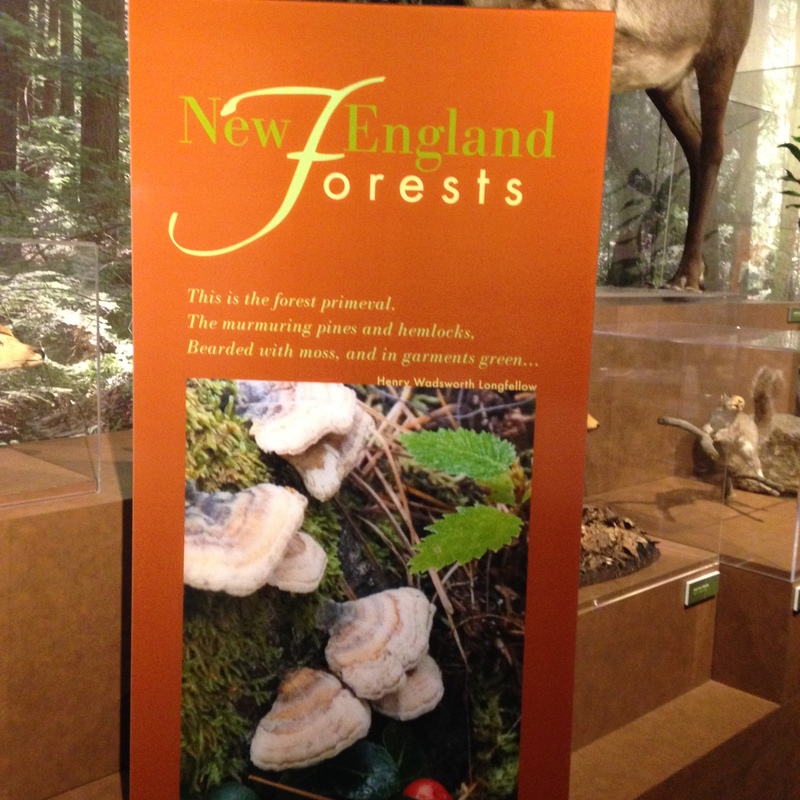Harvard Natural History Museum: New England Forests Exhibit Analysis
The Harvard Museum of Natural History features a broad assortment of exhibits. Together, these exhibits attempt to evoke interest in patrons about the natural sciences. This goal is not surprising given that this museum is at a university. Examined in smaller compartments, we can understand more specifically how each exhibit contributes towards this overarching goal. All of the public exhibits are on the third floor of the museum, and when you walk up the stairs to the third floor, you have the choice of exploring exhibits to the right and to your left. To the right are the exhibits for “Earth and Planetary Sciences” and for “Climate Change”. To the left are exhibits themed around evolution, specific organism types, and life in different ecosystems. The exhibits to the right seem geared towards non-living sciences while the exhibits on the left are more geared towards generating interest in past life forms or living systems. There are 13 exhibits on the left side and only 2 exhibits on the right side of the museum, which suggests a bias towards the study of life in the pre-human past.
The two major themes of the biological side of the museum are evolution and ecosystems. The first exhibit that a patron would encounter upon entering the left side of the museum is a room about evolution which introduced a time element to the museum. The evolution exhibit included diagrams about the earliest living creatures. The later exhibits about specific animals were arranged to be explored in chronological order from when these creatures developed (for example, the arthropod exhibit is before the vertebrate paleontology exhibit. The second half of the left side of museum focuses on different ecosystems around the globe and what animals live in each. While most exhibits covered a geographically large region like Africa, Asia, South America, and Marine Life, the exhibit I studied was New England Forests. This exhibit stood out to me because of the difference in size scale between for example, the ocean and New England forests. I suspect that a disproportionate weight is placed on New England forests because the museum itself is located in New England. I assume that donors to the museum were interested in science and probably spent some time in New England, so maybe someone made a donation towards a New England forests exhibit. Or, maybe a curator was particularly interested in New England forests. It is curious that a New England forests exhibit exists rather than a North American, Australian, Antarctic, or European exhibit.
One explanation is that curators designed this exhibit with the goal of attempting to relate what patrons learn in the museum to their nearby environment. Someone who visited the museum could also make a trip to a New England forest and try to connect what they learned at the museum to the real world. Patrons might also be more interested in an exhibit with local relevance. This exhibit seemed to have an overarching theme of conservation. There were aspects of the exhibit which interacted with different senses, and it even had a handout with activities that could be done in the exhibit for young children. The back of the handout recommended going outside and engaging with New England’s forests. This handout demonstrates that the patrons were interested in engaging an audience of all ages. Young children could touch the bark of trees and look for baby animals around the exhibit while more mature patrons could also learn from the displays and texts which accompanied different sections.
This exhibit was carefully designed to recreate an experience in the forest to inspire people to visit a forest for themselves. Visual displays like wolves and moose and plants were used in conjunction with a soundtrack playing birds singing, frogs croaking, crickets chirping, and water splashing, and also sources for a tactile learning experience like the rock texture, tree bark, and interactive touch displays. This combination of sensory inputs puts the patron in the forest and shows him or her on multiple levels how interesting New England forests are. The call for conservation of these forests is more effective when people are more invested in the forests, and the overall forest experience provided by the exhibit is supposed to inspire people to visit the nearby forests, which would make them more likely to support their conservation.
The lighting in this exhibit is a little bit dimmer than in other exhibits around it, and there are tree leaves on some portions of the ceiling. The dimmer lights recreate the experience of being under a canopy, and the tree leaves create noticeable light patterns when walking under them. The whole exhibit is themed for the patron to feel like they’re in a forest. Even the benches are designed to look like logs. The exhibit is immediately engaging from when a patron first enters, because a large wolf is placed in a high location and its head is directed towards the entrance. This exhibit recognizes that our culture is a selfish one, since people are more likely to support the ecosystems that they are familiar with, which is why there was a disproportionately large effort put into an exhibit on a local ecosystem.

